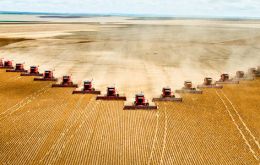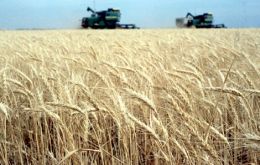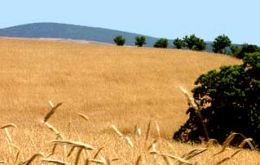MercoPress. South Atlantic News Agency
Tag: wheat
-
Friday, November 4th 2011 - 08:20 UTC
FAO food price index drops in October but remains higher than in 2010 and volatile

The FAO Food price index dropped to an 11-month low in October, declining 4%, or nine points, to 216 points from September. Nonetheless prices still remain generally higher than last year and very volatile, FAO said.
-
Monday, August 15th 2011 - 11:56 UTC
USDA estimates Argentine 2011/12 wheat crop at 13.5 million

The coming 2011/12 wheat crop of Argentina will reach 13.5 million tons instead of the 15 million forecasted last July, reported the US Agriculture Department, USDA.
-
Thursday, August 4th 2011 - 06:28 UTC
Uruguay soy crop reached 1.5 million tons with average yield of 1.788 kilos

Soybean was king of corps in Uruguay last summer with 1.5 million tons planted in 862.000 hectares and with an average yield of 1.788 kilos per ha, according to the latest data from the country’s Agriculture Statistics Office, DIEA.
-
Wednesday, July 27th 2011 - 03:48 UTC
Argentine farmers furious with government’s wheat export policy

Argentina liberated 450.000 tons of wheat for export, a decision which is believed to be closely linked to Sunday’s election in the farming province of Santa Fe where the government of President Cristina Fernandez de Kirchner suffered a major defeat.
-
Tuesday, March 22nd 2011 - 08:19 UTC
Argentina’s 2010/11 harvest estimated at over 100 million tons

Argentina’s 2010/2011 grains and oilseeds harvest is estimated to have reached 100.46 million tons, which is above last year’s according to the latest technical report from the Ministry of Agriculture released this week.
-
Thursday, February 17th 2011 - 23:01 UTC
Good harvest year for Argentina farmers and the tax man, in spite of drought

A good crop year for Argentine farmers and the government: export revenue will be up 4 billion US dollars and the tax man will bag an additional 888 million US dollars according to estimates from local grain dealers.
-
Tuesday, February 15th 2011 - 11:35 UTC
Extreme weather and panic buying send wheat soaring to new highs

Countries anxious to avoid a repeat of the 2007-2008 global food crisis when they were caught short of grain supplies, have stepped up their buying programs and are driving prices to new highs.
-
Tuesday, February 15th 2011 - 05:34 UTC
US farmers have planted the biggest crop in 13 years reports USDA

United States farmers have planted the biggest crop in thirteen years according to a report released by the US Department of Agriculture which estimated the area sown to the eight major field crops in 2011 at 103.3 million hectares.
-
Monday, January 31st 2011 - 21:30 UTC
FAO, IMF anticipate more civil unrest and protests because of soaring food prices

North Africa and Middle East civil unrest can be expected to spread to several other countries if as anticipated the FAO Food Prices Index for January 2011 confirms the December 2010 tendency when the “basket” of food staples reached a new peak.
-
Wednesday, January 26th 2011 - 18:14 UTC
Argentine Wheat Exports May Fall to Lowest in Almost Three Decades

Wheat sales for the 2009-2010 season in Argentina are primarily from the crop harvested through January 2010, which was curbed by water shortages, reports Bloomberg.
